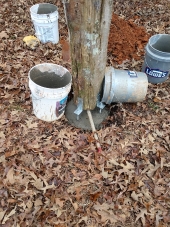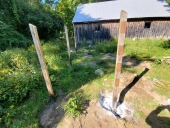Brett makes a very good point and one I was going to mention as well. Heavy, poorly drained soils (like the clay I have here in SW Ohio) will create a pool of water around the post that saturates the sand/stone fill, and accelerates rot.
Locust can last several years but most other wood stays water saturated and softens quickly. Water pools in post holes so well here, that if you sink a green post it will often sprout. We actually has nine, fifteen foot tall green posts (we put up a temporary tarp shelter for a large gathering) put out some twigs and leaves, a few weeks after we placed them. They were cut green and placed in a three foot deep post hole backfilled with crushed gravel with fines. These were placed on high ground that drained down into a creek about thirty yards away. Even with the slope and nearby drainage, the post sprouted like they were prized cuttings placed in a vase.
From what I can see on soil maps, you have a similar soil in southern Illinois.
If that is true and you are also dealing with heavy clay, I wouldn't consider placing wood in the ground unless you are planning a major water management project around the building. TBH, I still wouldn't do it. For anything permanent, here, we put stone/concrete in the ground and the wood on top of that.










